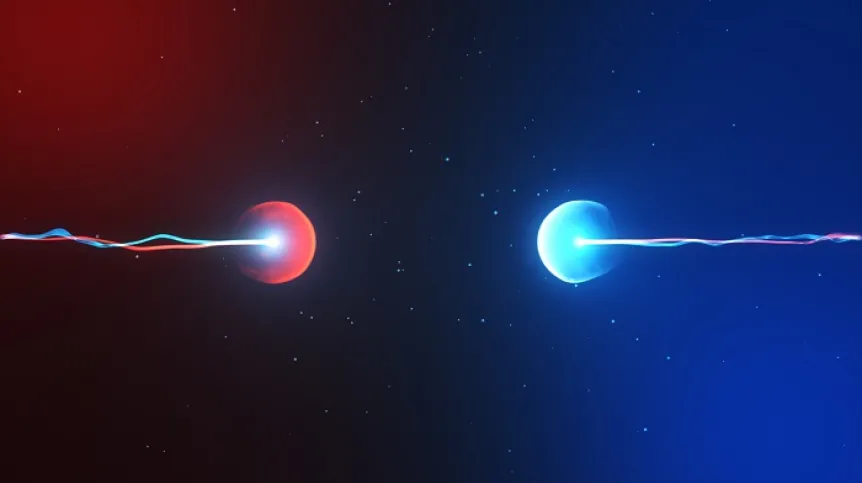
Here's the scientific equivalent of 'Look at the images and find 10 differences': finding the differences between matter and antimatter. There is a lot at stake: it is the answer to the question of why we exist. Now, physicists, working as part of the LHCb experiment at the European nuclear facility CERN, has made another (but not yet the last) difference.
Right after the Big Bang it is assumed that equal numbers of particles of matter and antimatter should have been formed. A particle has the opposite charge and is a mirror image of its antiparticle. And when the two meet – they are annihilated. It would seem that all particles and antiparticles should immediately turn into energy in the processes of annihilation. But they didn't, because there is life, Universe… and everything. And we are made of matter. Antimatter, on the other hand, is quite rare.
Subtle differences between the matter and antimatter must have accounted for the survival of the matter that made up our world. Some of them have been known for years. Now an international team of physicists, working as part of the LHCb experiment at the European nuclear facility CERN, has made another building block to this complex puzzle, seemingly small but of great importance. Representatives of the National Centre for Nuclear Research in Świerk report on the research project in a release sent to PAP.
Mesons are attractive objects for research into CP symmetry breaking.
Mesons are unstable particles, but live long enough for their properties to be studied. The first mesons (pions) were discovered in the first half of the 20th century in cosmic rays. Today we know that they are composed of a pair of a quark and an antiquark, and since we have six types of quarks (physicists talk about six smells, which has absolutely nothing to do with the olfactory sensations of everyday life!), there are really many combinations leading to different mesons. Every meson also has its antiparticle, in which the relevant quarks and antiquarks are replaced with their antiparticles.
The breaking of CP symmetry in the decays of neutral kaons (mesons with a quark and an upper and a strange antiquark) was observed over half a century ago and awarded the Nobel Prize. Twenty years ago, symmetry breaking was also noticed among mesons containing a beauty quark. The mystery, among other things, were the mesons with the charm quark, which in terms of mass is between the strange and the beauty quark.
“Until now, we have not been able to measure directly and with the appropriate precision how the breaking of CP symmetry manifests itself in the decays of charm mesons. The results of the analyses presented at the recently completed ICHEP high energy physics conference in Bologna perfectly fill this gap,” says Professor Wojciech Wiślicki from the National Centre for Nuclear Research.
The latest results are the outcome of detailed analyses of about fifty million cases with the decay of D0 charm mesons into positively and negatively charged kaons. These decays were recorded over several years during proton collisions in the LHCb detector at the Large Hadron Collider at the CERN facility near Geneva. Part of the calculations related to data processing were carried out in the Świerk IT Centre.
'In fact, breaking the space-charge symmetry in the decays of charm mesons was first noticed in the LHCb experiment three years ago,” explains Dr. Artur Ukleja from the National Centre for Nuclear Research. “Contrary to the current measurement, that measurement did not suggest so clearly the possible different matter-antimatter asymmetries between the decays of charm mesons into kaon-antikaon pairs and decays into pion-antipion pairs.”
The physicists comment that the latest results of LHCb detector experiments significantly complement our understanding of the difference between matter and antimatter. The Standard Model imposes restrictions on breaking the symmetry between matter and antimatter. If too many such phenomena were observed, the result would be inconsistent with the predictions of the Standard Model, signalling the existence of a new physics.
“The data presented in Bologna show that breaking the CP symmetry rarely occurs in the case of charm mesons,” says Professor Wiślicki. So rarely in fact, that these results do not contradict the Standard Model used to describe elementary particles and their interactions.
The physicists explain that the discrepancy between the amount of matter observed in the Universe and the predictions of our cosmological models remains apparent even with the most recent results. Apparently, this is not the last difference between matter and antimatter. “More clues to unravel this mystery may be seen in the next stage of particle collisions in the LHC accelerator, which has just begun,” say the physicists.
PAP - Science in Poland
lt/ zan/ kap/
tr. RL













